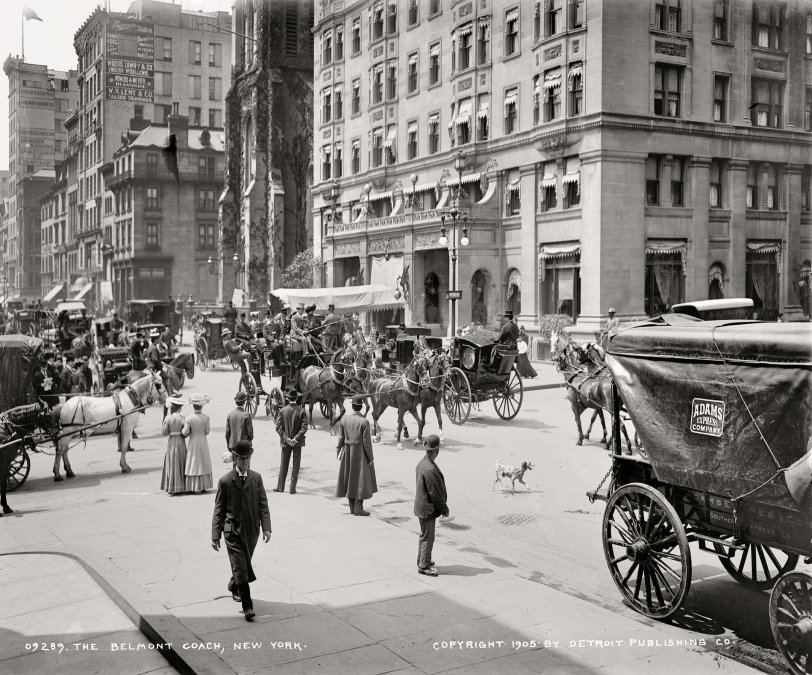


Framed or unframed, desk size to sofa size, printed by us in Arizona and Alabama since 2007. Explore now.
Shorpy is funded by you. Patreon contributors get an ad-free experience.
Learn more.

- Baldwin 62303
- Baldwin VO-1000
- Cold
- No expense spared
- Tough Guys
- Lost in Toyland
- And without gloves
- If I were a blindfolded time traveler
- Smoke Consumer Also Cooks
- Oh that stove!
- Possibly still there?
- What?!?
- $100 Reward
- Freeze Frame
- Texas Flyer wanted
- Just a Year Too Soon
- WWII -- Replacing men with women at the railroad crossing.
- Yes, Icing
- You kids drive me nuts!
- NOT An Easy Job
- I wonder
- Just add window boxes
- Icing Platform?
- Indiana Harbor Belt abides
- Freezing haze
- Corrections (for those who care)
- C&NW at Nelson
- Fallen Flags
- A dangerous job made worse
- Water Stop
Print Emporium
The Belmont Coach: 1905

New York circa 1905. "The Belmont coach." Alfred Vanderbilt's Belmont Park four-in-hand passing the Holland House Hotel on Fifth Avenue, in the days when "coaching" was a favored pastime of millionaire sportsmen. View full size.
Free Dog II
I'm with Jimmy Longshanks. I too love seeing random dogs going about their business without a care in the world. This dog looks very happy in his work. Like those cool dragon lamps, I briefly wonder what became of him?
Cool lamps!
Check out the cool dragon lamps on the front of the hotel. I wonder if they are lying in some basement somewhere gathering dust?
Fifth Avenue
I assume that this is Fifth Avenue in the fifties, looking southwest, or is it northeast? Can anyone identify the church in the background?
[The street sign on the lamppost says West 30th. - Dave]
Horseless carriage
Following the four-in-hand (look to its left and in the background) is a horseless carriage. The driver appears to be operating a tiller.
Vanderbilt's horses
From around 1900 and into the 1920s, Charles Hersig, founding owner of the Wyoming Hereford Ranch, and my father's guardian, bred and trained high quality carriage and riding horses that he sold every year to the horsey members of the New York 400. The team pulling Vanderbilt's drag (which is what they called these heavy English mail coaches) quite possibly came from Hersig. Each year he took a trainload of horses East, a couple of weeks before the start of the racing season at Belmont Park, and always sold out.
His wife Ida told my father that one year around 1902, when she went with Charlie for the New York sale, they were invited to a customer's Opening Day box at the racetrack, and, ironically, Uncle Charlie had to rent a buggy and a skittish young horse from a livery stable to get there. The drive to Belmont Park was crowded with carriages and at least ten of these big yellow and black drags, loaded with millionaires, when Charlie's horse panicked and bolted.
As Aunt Ida held on for dear life, Charlie stood up in the box like a charioteer to let the horse run himself out. She said she was pretty mortified when they passed Vanderbilt's drag, and he and all his friends were laughing in admiration, blowing on coach horns to clear the road ahead, and shouting "Give 'im hell, Charlie, give 'im hell!"
Outlaw Pooch
If that dog tried running on Fifth Ave. today, the police would slap a $200 ticket on him for not having a leash.
Spot the Carriage Dog
The New York Times - November 18, 1900 - It Is commonly believed that the spotted carriage dogs, once so frequently kept in England, were about the most useless creatures of the dog kind, maintained only for show and fashion. This is a mistake. They were used at a time when a traveling carriage carried, besides its owners, a large amount of valuable property, and the dogs watched the carriage at night when the owners were sleeping at country inns.
Free dog!
I like a dog in charge of his own recreation.
A watery end
Alfred Vanderbilt, a passenger aboard the Cunard liner Lusitania, drowned at sea when the ship was torpedoed by a German submarine in 1915. His body was never recovered. A memorial stone was erected in London.
"In Memory of Alfred Gwynne Vanderbilt a gallant gentleman and a fine sportsman who perished in the Lusitania May 7th 1915. This stone is erected on his favourite road by a few of his British coaching friends and admirers."
By all accounts this man of wealth died nobly after giving his life jacket to a woman holding her baby.
























On Shorpy:
Today’s Top 5